Course Name: Mesoporous Silica Nanoparticles Applications Report
VerifiedAdded on 2020/05/04
|6
|1263
|33
Report
AI Summary
This report provides a comprehensive review of the applications of mesoporous silica nanoparticles (MSNs) in various fields. The introduction highlights the significance of nanotechnology and the unique properties of MSNs. The report then delves into specific applications, including the detection of microorganisms, particularly E. coli, using MSN-based biosensors. It explores how MSNs are used in drug delivery systems due to their high surface area and pore volume, enabling controlled drug release and targeted delivery to cancer cells. Furthermore, the report examines the use of MSNs in diagnosis and imaging, such as in the detection of breast cancer. The report discusses the biocompatibility and chemical stability of MSNs, making them ideal for various biomedical applications. The paper concludes with a list of relevant references.

Mesoporous Silica Nanoparticles
Application of Mesoporous Silica Nanoparticles
By Student’s Name
Course Number and Name
Lecturer’s Name
University Name
City, State
Date
Page 1 of 6
Application of Mesoporous Silica Nanoparticles
By Student’s Name
Course Number and Name
Lecturer’s Name
University Name
City, State
Date
Page 1 of 6
Paraphrase This Document
Need a fresh take? Get an instant paraphrase of this document with our AI Paraphraser
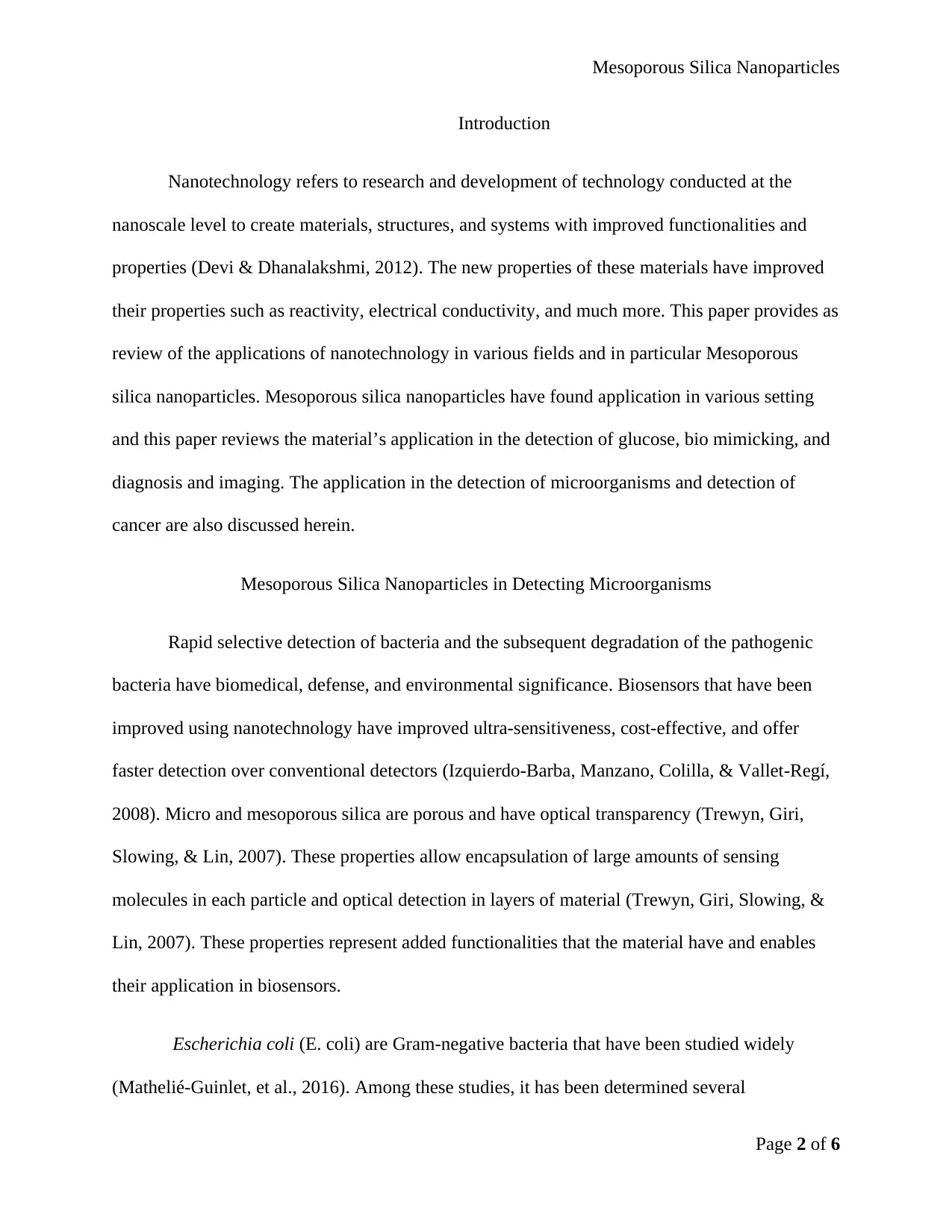
Mesoporous Silica Nanoparticles
Introduction
Nanotechnology refers to research and development of technology conducted at the
nanoscale level to create materials, structures, and systems with improved functionalities and
properties (Devi & Dhanalakshmi, 2012). The new properties of these materials have improved
their properties such as reactivity, electrical conductivity, and much more. This paper provides as
review of the applications of nanotechnology in various fields and in particular Mesoporous
silica nanoparticles. Mesoporous silica nanoparticles have found application in various setting
and this paper reviews the material’s application in the detection of glucose, bio mimicking, and
diagnosis and imaging. The application in the detection of microorganisms and detection of
cancer are also discussed herein.
Mesoporous Silica Nanoparticles in Detecting Microorganisms
Rapid selective detection of bacteria and the subsequent degradation of the pathogenic
bacteria have biomedical, defense, and environmental significance. Biosensors that have been
improved using nanotechnology have improved ultra-sensitiveness, cost-effective, and offer
faster detection over conventional detectors (Izquierdo-Barba, Manzano, Colilla, & Vallet-Regí,
2008). Micro and mesoporous silica are porous and have optical transparency (Trewyn, Giri,
Slowing, & Lin, 2007). These properties allow encapsulation of large amounts of sensing
molecules in each particle and optical detection in layers of material (Trewyn, Giri, Slowing, &
Lin, 2007). These properties represent added functionalities that the material have and enables
their application in biosensors.
Escherichia coli (E. coli) are Gram-negative bacteria that have been studied widely
(Mathelié-Guinlet, et al., 2016). Among these studies, it has been determined several
Page 2 of 6
Introduction
Nanotechnology refers to research and development of technology conducted at the
nanoscale level to create materials, structures, and systems with improved functionalities and
properties (Devi & Dhanalakshmi, 2012). The new properties of these materials have improved
their properties such as reactivity, electrical conductivity, and much more. This paper provides as
review of the applications of nanotechnology in various fields and in particular Mesoporous
silica nanoparticles. Mesoporous silica nanoparticles have found application in various setting
and this paper reviews the material’s application in the detection of glucose, bio mimicking, and
diagnosis and imaging. The application in the detection of microorganisms and detection of
cancer are also discussed herein.
Mesoporous Silica Nanoparticles in Detecting Microorganisms
Rapid selective detection of bacteria and the subsequent degradation of the pathogenic
bacteria have biomedical, defense, and environmental significance. Biosensors that have been
improved using nanotechnology have improved ultra-sensitiveness, cost-effective, and offer
faster detection over conventional detectors (Izquierdo-Barba, Manzano, Colilla, & Vallet-Regí,
2008). Micro and mesoporous silica are porous and have optical transparency (Trewyn, Giri,
Slowing, & Lin, 2007). These properties allow encapsulation of large amounts of sensing
molecules in each particle and optical detection in layers of material (Trewyn, Giri, Slowing, &
Lin, 2007). These properties represent added functionalities that the material have and enables
their application in biosensors.
Escherichia coli (E. coli) are Gram-negative bacteria that have been studied widely
(Mathelié-Guinlet, et al., 2016). Among these studies, it has been determined several
Page 2 of 6
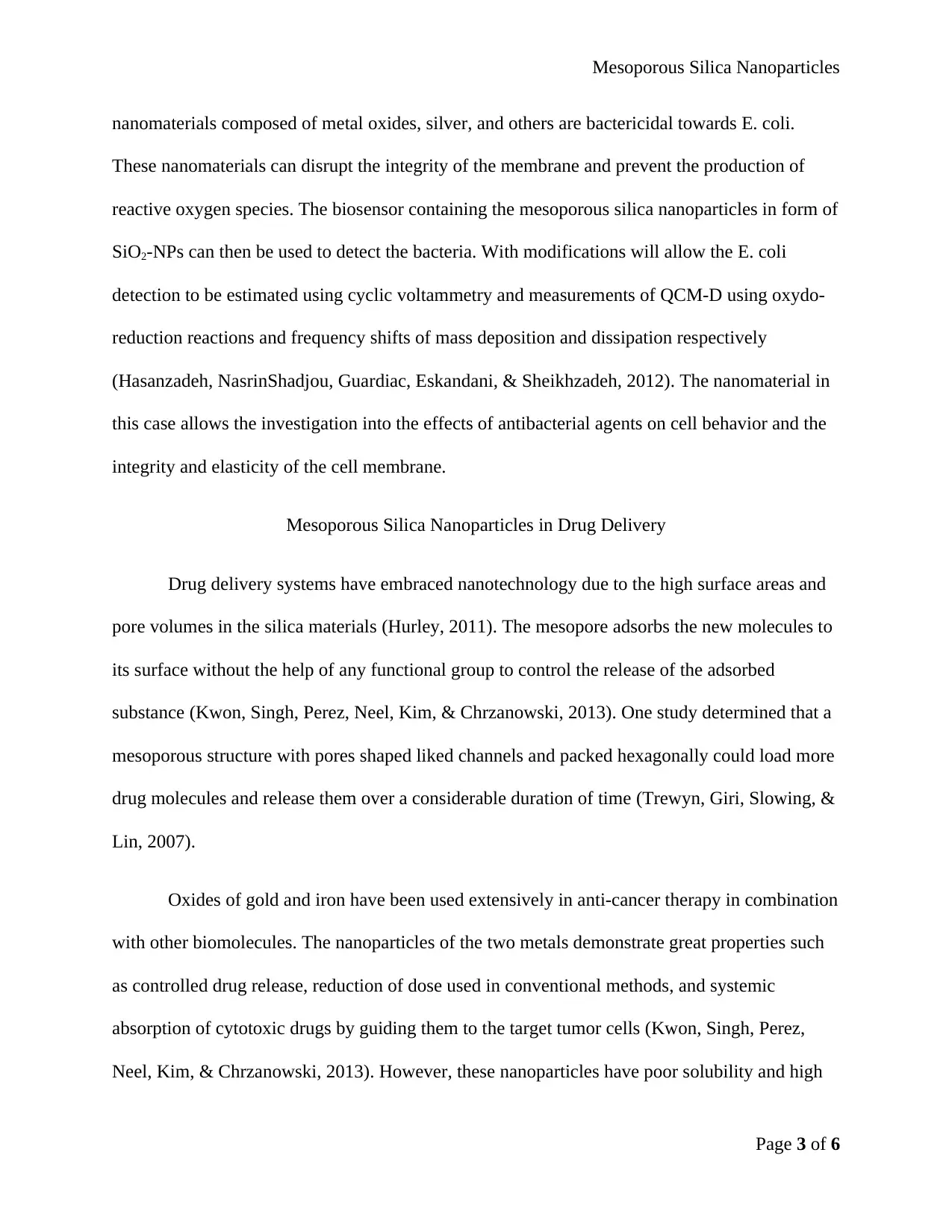
Mesoporous Silica Nanoparticles
nanomaterials composed of metal oxides, silver, and others are bactericidal towards E. coli.
These nanomaterials can disrupt the integrity of the membrane and prevent the production of
reactive oxygen species. The biosensor containing the mesoporous silica nanoparticles in form of
SiO2-NPs can then be used to detect the bacteria. With modifications will allow the E. coli
detection to be estimated using cyclic voltammetry and measurements of QCM-D using oxydo-
reduction reactions and frequency shifts of mass deposition and dissipation respectively
(Hasanzadeh, NasrinShadjou, Guardiac, Eskandani, & Sheikhzadeh, 2012). The nanomaterial in
this case allows the investigation into the effects of antibacterial agents on cell behavior and the
integrity and elasticity of the cell membrane.
Mesoporous Silica Nanoparticles in Drug Delivery
Drug delivery systems have embraced nanotechnology due to the high surface areas and
pore volumes in the silica materials (Hurley, 2011). The mesopore adsorbs the new molecules to
its surface without the help of any functional group to control the release of the adsorbed
substance (Kwon, Singh, Perez, Neel, Kim, & Chrzanowski, 2013). One study determined that a
mesoporous structure with pores shaped liked channels and packed hexagonally could load more
drug molecules and release them over a considerable duration of time (Trewyn, Giri, Slowing, &
Lin, 2007).
Oxides of gold and iron have been used extensively in anti-cancer therapy in combination
with other biomolecules. The nanoparticles of the two metals demonstrate great properties such
as controlled drug release, reduction of dose used in conventional methods, and systemic
absorption of cytotoxic drugs by guiding them to the target tumor cells (Kwon, Singh, Perez,
Neel, Kim, & Chrzanowski, 2013). However, these nanoparticles have poor solubility and high
Page 3 of 6
nanomaterials composed of metal oxides, silver, and others are bactericidal towards E. coli.
These nanomaterials can disrupt the integrity of the membrane and prevent the production of
reactive oxygen species. The biosensor containing the mesoporous silica nanoparticles in form of
SiO2-NPs can then be used to detect the bacteria. With modifications will allow the E. coli
detection to be estimated using cyclic voltammetry and measurements of QCM-D using oxydo-
reduction reactions and frequency shifts of mass deposition and dissipation respectively
(Hasanzadeh, NasrinShadjou, Guardiac, Eskandani, & Sheikhzadeh, 2012). The nanomaterial in
this case allows the investigation into the effects of antibacterial agents on cell behavior and the
integrity and elasticity of the cell membrane.
Mesoporous Silica Nanoparticles in Drug Delivery
Drug delivery systems have embraced nanotechnology due to the high surface areas and
pore volumes in the silica materials (Hurley, 2011). The mesopore adsorbs the new molecules to
its surface without the help of any functional group to control the release of the adsorbed
substance (Kwon, Singh, Perez, Neel, Kim, & Chrzanowski, 2013). One study determined that a
mesoporous structure with pores shaped liked channels and packed hexagonally could load more
drug molecules and release them over a considerable duration of time (Trewyn, Giri, Slowing, &
Lin, 2007).
Oxides of gold and iron have been used extensively in anti-cancer therapy in combination
with other biomolecules. The nanoparticles of the two metals demonstrate great properties such
as controlled drug release, reduction of dose used in conventional methods, and systemic
absorption of cytotoxic drugs by guiding them to the target tumor cells (Kwon, Singh, Perez,
Neel, Kim, & Chrzanowski, 2013). However, these nanoparticles have poor solubility and high
Page 3 of 6
⊘ This is a preview!⊘
Do you want full access?
Subscribe today to unlock all pages.

Trusted by 1+ million students worldwide
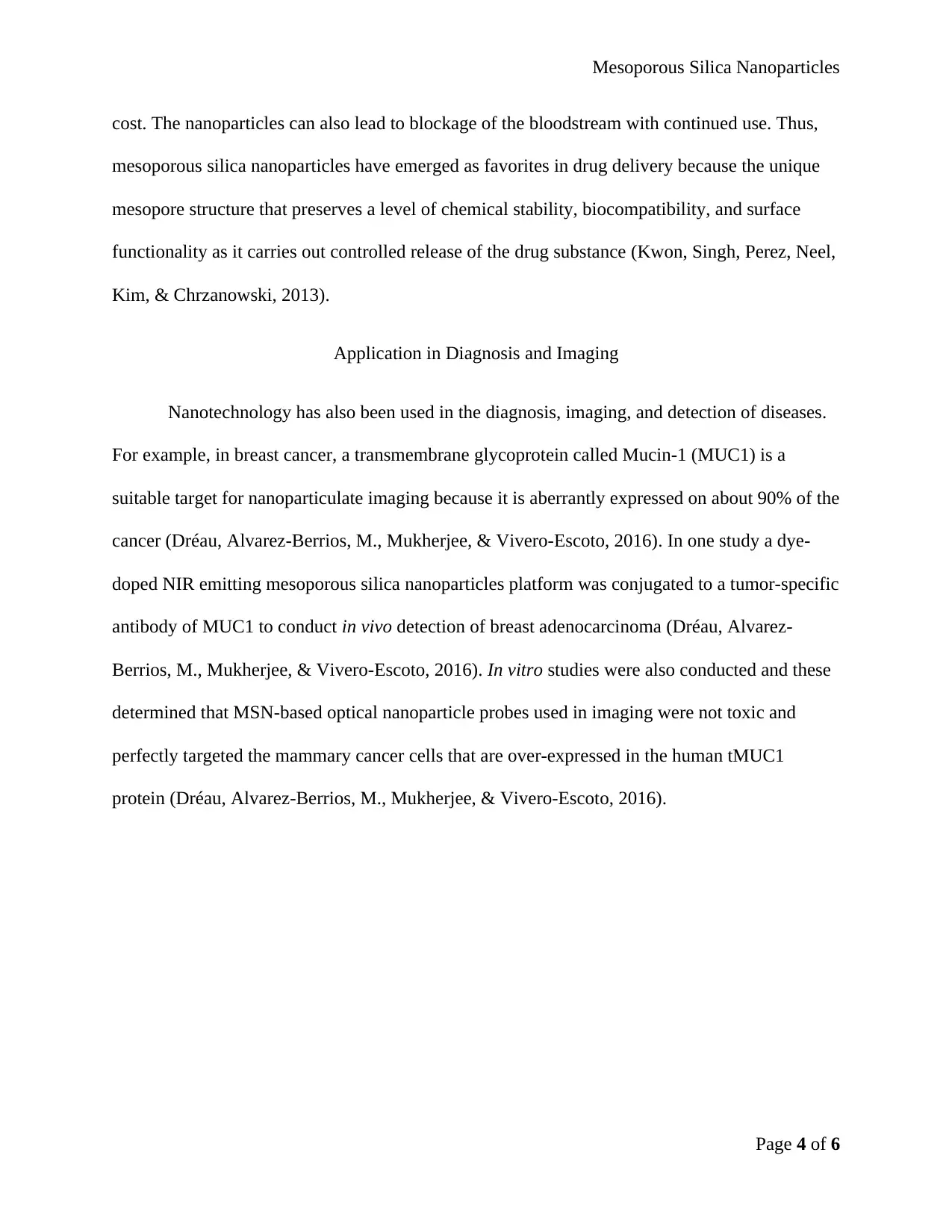
Mesoporous Silica Nanoparticles
cost. The nanoparticles can also lead to blockage of the bloodstream with continued use. Thus,
mesoporous silica nanoparticles have emerged as favorites in drug delivery because the unique
mesopore structure that preserves a level of chemical stability, biocompatibility, and surface
functionality as it carries out controlled release of the drug substance (Kwon, Singh, Perez, Neel,
Kim, & Chrzanowski, 2013).
Application in Diagnosis and Imaging
Nanotechnology has also been used in the diagnosis, imaging, and detection of diseases.
For example, in breast cancer, a transmembrane glycoprotein called Mucin-1 (MUC1) is a
suitable target for nanoparticulate imaging because it is aberrantly expressed on about 90% of the
cancer (Dréau, Alvarez-Berrios, M., Mukherjee, & Vivero-Escoto, 2016). In one study a dye-
doped NIR emitting mesoporous silica nanoparticles platform was conjugated to a tumor-specific
antibody of MUC1 to conduct in vivo detection of breast adenocarcinoma (Dréau, Alvarez-
Berrios, M., Mukherjee, & Vivero-Escoto, 2016). In vitro studies were also conducted and these
determined that MSN-based optical nanoparticle probes used in imaging were not toxic and
perfectly targeted the mammary cancer cells that are over-expressed in the human tMUC1
protein (Dréau, Alvarez-Berrios, M., Mukherjee, & Vivero-Escoto, 2016).
Page 4 of 6
cost. The nanoparticles can also lead to blockage of the bloodstream with continued use. Thus,
mesoporous silica nanoparticles have emerged as favorites in drug delivery because the unique
mesopore structure that preserves a level of chemical stability, biocompatibility, and surface
functionality as it carries out controlled release of the drug substance (Kwon, Singh, Perez, Neel,
Kim, & Chrzanowski, 2013).
Application in Diagnosis and Imaging
Nanotechnology has also been used in the diagnosis, imaging, and detection of diseases.
For example, in breast cancer, a transmembrane glycoprotein called Mucin-1 (MUC1) is a
suitable target for nanoparticulate imaging because it is aberrantly expressed on about 90% of the
cancer (Dréau, Alvarez-Berrios, M., Mukherjee, & Vivero-Escoto, 2016). In one study a dye-
doped NIR emitting mesoporous silica nanoparticles platform was conjugated to a tumor-specific
antibody of MUC1 to conduct in vivo detection of breast adenocarcinoma (Dréau, Alvarez-
Berrios, M., Mukherjee, & Vivero-Escoto, 2016). In vitro studies were also conducted and these
determined that MSN-based optical nanoparticle probes used in imaging were not toxic and
perfectly targeted the mammary cancer cells that are over-expressed in the human tMUC1
protein (Dréau, Alvarez-Berrios, M., Mukherjee, & Vivero-Escoto, 2016).
Page 4 of 6
Paraphrase This Document
Need a fresh take? Get an instant paraphrase of this document with our AI Paraphraser
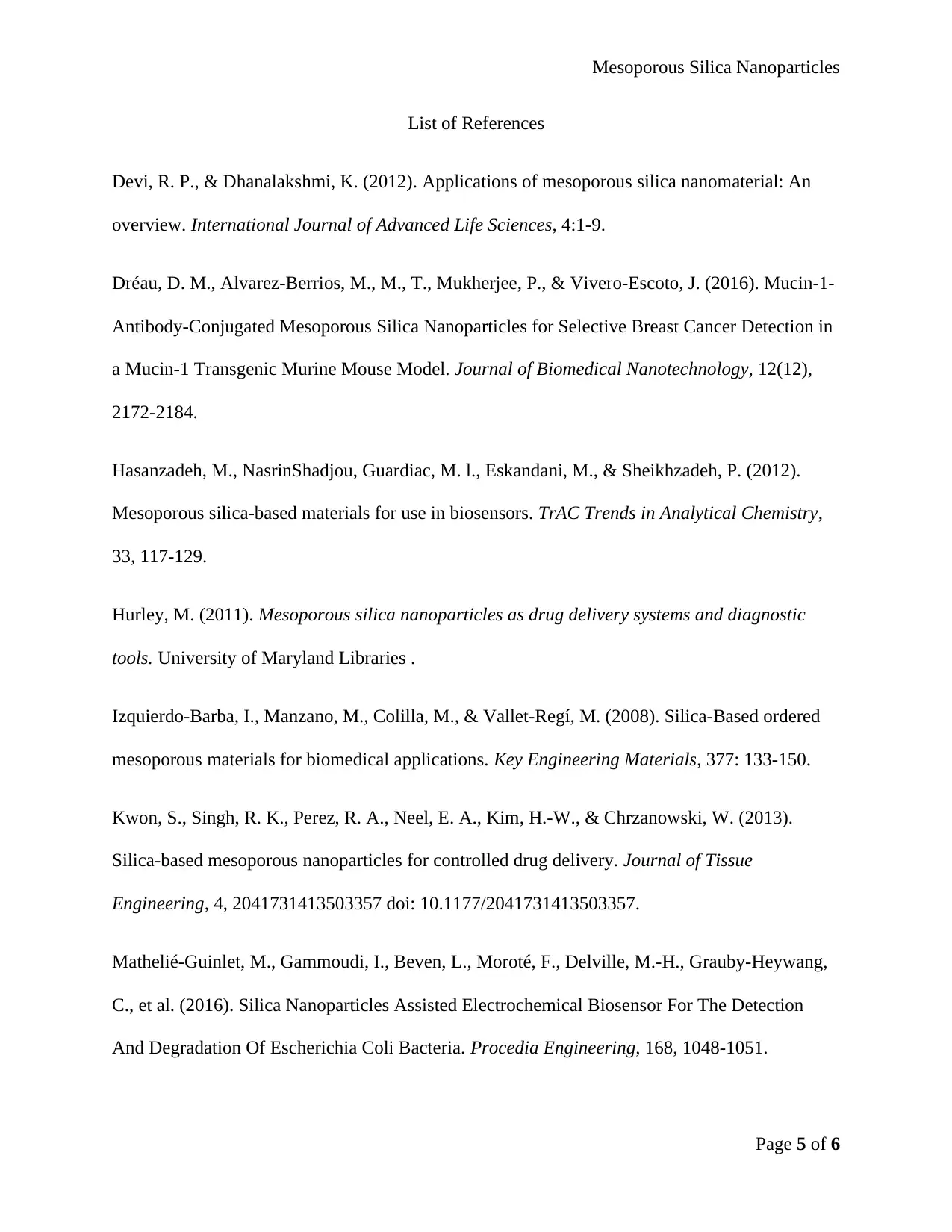
Mesoporous Silica Nanoparticles
List of References
Devi, R. P., & Dhanalakshmi, K. (2012). Applications of mesoporous silica nanomaterial: An
overview. International Journal of Advanced Life Sciences, 4:1-9.
Dréau, D. M., Alvarez-Berrios, M., M., T., Mukherjee, P., & Vivero-Escoto, J. (2016). Mucin-1-
Antibody-Conjugated Mesoporous Silica Nanoparticles for Selective Breast Cancer Detection in
a Mucin-1 Transgenic Murine Mouse Model. Journal of Biomedical Nanotechnology, 12(12),
2172-2184.
Hasanzadeh, M., NasrinShadjou, Guardiac, M. l., Eskandani, M., & Sheikhzadeh, P. (2012).
Mesoporous silica-based materials for use in biosensors. TrAC Trends in Analytical Chemistry,
33, 117-129.
Hurley, M. (2011). Mesoporous silica nanoparticles as drug delivery systems and diagnostic
tools. University of Maryland Libraries .
Izquierdo-Barba, I., Manzano, M., Colilla, M., & Vallet-Regí, M. (2008). Silica-Based ordered
mesoporous materials for biomedical applications. Key Engineering Materials, 377: 133-150.
Kwon, S., Singh, R. K., Perez, R. A., Neel, E. A., Kim, H.-W., & Chrzanowski, W. (2013).
Silica-based mesoporous nanoparticles for controlled drug delivery. Journal of Tissue
Engineering, 4, 2041731413503357 doi: 10.1177/2041731413503357.
Mathelié-Guinlet, M., Gammoudi, I., Beven, L., Moroté, F., Delville, M.-H., Grauby-Heywang,
C., et al. (2016). Silica Nanoparticles Assisted Electrochemical Biosensor For The Detection
And Degradation Of Escherichia Coli Bacteria. Procedia Engineering, 168, 1048-1051.
Page 5 of 6
List of References
Devi, R. P., & Dhanalakshmi, K. (2012). Applications of mesoporous silica nanomaterial: An
overview. International Journal of Advanced Life Sciences, 4:1-9.
Dréau, D. M., Alvarez-Berrios, M., M., T., Mukherjee, P., & Vivero-Escoto, J. (2016). Mucin-1-
Antibody-Conjugated Mesoporous Silica Nanoparticles for Selective Breast Cancer Detection in
a Mucin-1 Transgenic Murine Mouse Model. Journal of Biomedical Nanotechnology, 12(12),
2172-2184.
Hasanzadeh, M., NasrinShadjou, Guardiac, M. l., Eskandani, M., & Sheikhzadeh, P. (2012).
Mesoporous silica-based materials for use in biosensors. TrAC Trends in Analytical Chemistry,
33, 117-129.
Hurley, M. (2011). Mesoporous silica nanoparticles as drug delivery systems and diagnostic
tools. University of Maryland Libraries .
Izquierdo-Barba, I., Manzano, M., Colilla, M., & Vallet-Regí, M. (2008). Silica-Based ordered
mesoporous materials for biomedical applications. Key Engineering Materials, 377: 133-150.
Kwon, S., Singh, R. K., Perez, R. A., Neel, E. A., Kim, H.-W., & Chrzanowski, W. (2013).
Silica-based mesoporous nanoparticles for controlled drug delivery. Journal of Tissue
Engineering, 4, 2041731413503357 doi: 10.1177/2041731413503357.
Mathelié-Guinlet, M., Gammoudi, I., Beven, L., Moroté, F., Delville, M.-H., Grauby-Heywang,
C., et al. (2016). Silica Nanoparticles Assisted Electrochemical Biosensor For The Detection
And Degradation Of Escherichia Coli Bacteria. Procedia Engineering, 168, 1048-1051.
Page 5 of 6
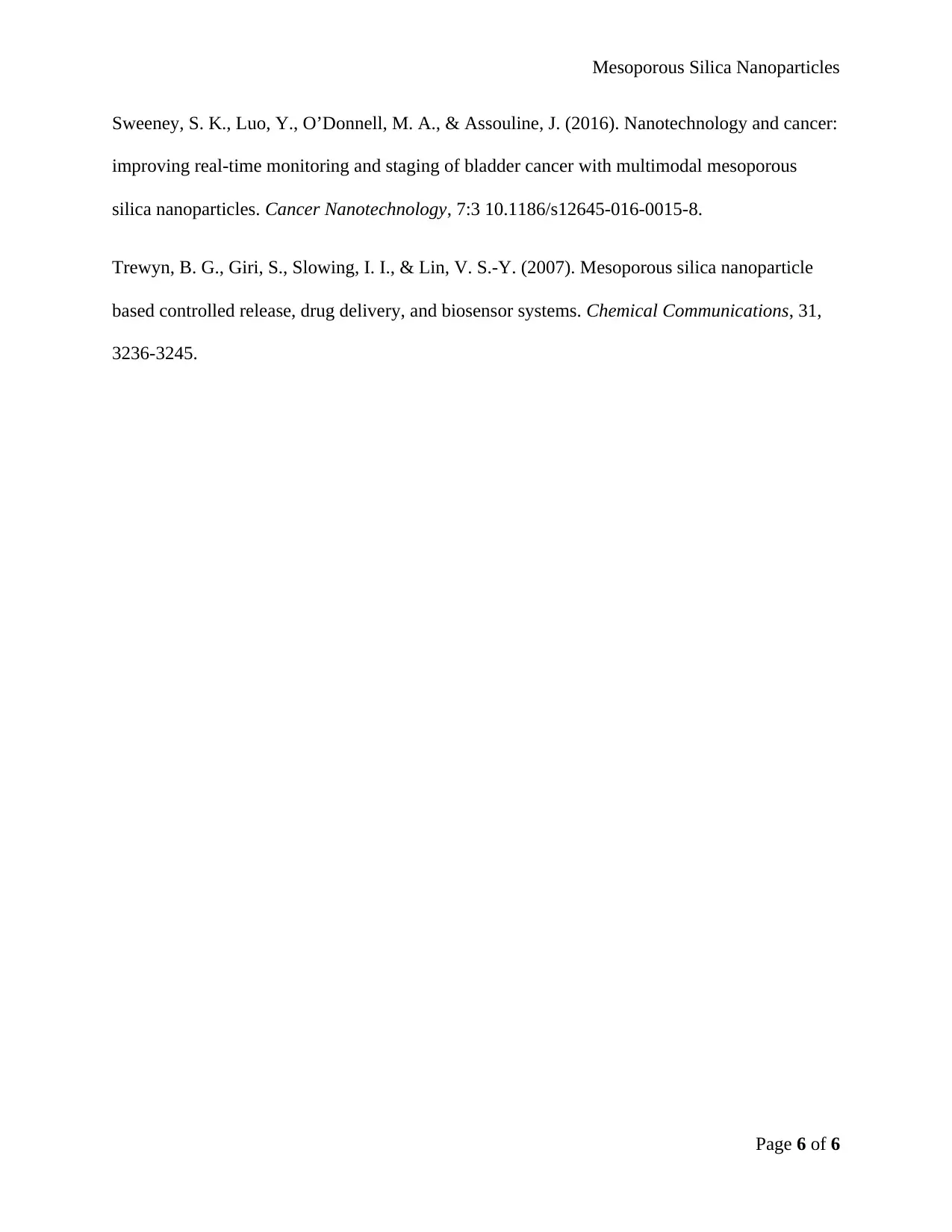
Mesoporous Silica Nanoparticles
Sweeney, S. K., Luo, Y., O’Donnell, M. A., & Assouline, J. (2016). Nanotechnology and cancer:
improving real-time monitoring and staging of bladder cancer with multimodal mesoporous
silica nanoparticles. Cancer Nanotechnology, 7:3 10.1186/s12645-016-0015-8.
Trewyn, B. G., Giri, S., Slowing, I. I., & Lin, V. S.-Y. (2007). Mesoporous silica nanoparticle
based controlled release, drug delivery, and biosensor systems. Chemical Communications, 31,
3236-3245.
Page 6 of 6
Sweeney, S. K., Luo, Y., O’Donnell, M. A., & Assouline, J. (2016). Nanotechnology and cancer:
improving real-time monitoring and staging of bladder cancer with multimodal mesoporous
silica nanoparticles. Cancer Nanotechnology, 7:3 10.1186/s12645-016-0015-8.
Trewyn, B. G., Giri, S., Slowing, I. I., & Lin, V. S.-Y. (2007). Mesoporous silica nanoparticle
based controlled release, drug delivery, and biosensor systems. Chemical Communications, 31,
3236-3245.
Page 6 of 6
⊘ This is a preview!⊘
Do you want full access?
Subscribe today to unlock all pages.

Trusted by 1+ million students worldwide
1 out of 6
Your All-in-One AI-Powered Toolkit for Academic Success.
+13062052269
info@desklib.com
Available 24*7 on WhatsApp / Email
![[object Object]](/_next/static/media/star-bottom.7253800d.svg)
Unlock your academic potential
Copyright © 2020–2025 A2Z Services. All Rights Reserved. Developed and managed by ZUCOL.
